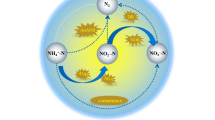Abstract
Naphthalene was used as a model compound in order to study the anaerobic pathway of polycyclic aromatic hydrocarbon degradation. Previously we had determined that carboxylation is an initial step for anaerobic metabolism of naphthalene, but no other intermediate metabolites were identified (Zhang & Young 1997). In the present study we further elucidate the pathway with the identification of six novel naphthalene metabolites detected when cultures were fed naphthalene in the presence of its analog 1-fluoronaphthalene. Results from cultures supplemented with either deuterated naphthalene or non-deuterated naphthalene plus [13C]bicarbonate confirm that the metabolites originated from naphthalene. Three of these metabolites were identified by comparison with the following standards: 2-naphthoic acid (2-NA), 5,6,7,8-tetrahydro-2-naphthoic acid, and decahydro-2-naphthoic acid. The presence of 5,6,7,8-tetrahydro-2-NA as a metabolite of naphthalene degradation indicates that the first reduction reaction occurs at the unsubstituted ring, rather than the carboxylated ring. The overall results suggest that after the initial carboxylation of naphthalene, 2-NA is sequentially reduced to decahydro-2-naphthoic acid through 5 hydrogenation reactions, each of which eliminated one double bond. Incorporation of deuterium atoms from D2O into 5,6,7,8-tetrahydro-2-naphthoic acid suggests that water is the proton source for hydrogenation.
Similar content being viewed by others
References
Al-Bashir B, Cseh R, Leduc R & Samson R (1990) Effect of soil/contaminant interactions on the biodegradation of naphthalene in flooded soil under denitrifying conditions. Appl. Microbiol. Biotechnol. 34: 414-419
Bedessem ME, Swoboda-Colberg NG & Colberg PJS (1997) Naphthalene mineralization coupled to sulfate reduction in aquiferderived enrichments. FEMS Microbiol. Lett. 152: 213-218
Bregnard TPA, Hohener P, Haner A & Zeyer J (1996) Degradation of weathered diesel fuel by microorganisms from a contaminated aquifer in aerobic and anaerobic microcosms. Environ. Toxicol. Chem. 15: 299-307
Cerniglia CE (1992) Biodegradation of polycyclic aromatic hydrocarbons. Biodegradation 3: 351-368
Coates JD, Anderson RT & Lovley DR (1996) Oxidation of polycyclic aromatic hydrocarbons under sulfate-reducing conditions. Appl. Environ. Microbiol. 62: 1099-1101
Coates JD, Woodward J, Allen J, Philp P & Loveley DR (1997) Anaerobic degradation of polycyclic aromatic hydrocarbons and alkanes in petroleum-contaminated marine harbor sediments. Appl. Environ. Microbiol. 63: 3589-3593
Dauben W, Hiskey CF & Markhart Jr AH (1951) The hydrogenation of hydroxynaphthoic acids. J. Am. Chem. Soc. 73: 1393-1400
Durant ND, Wilson LP & Bouwer EJ (1995) Microcosm studies of subsurface PAH-degrading bacteria from a former manufactured gas plant. J Contam. Hydrol. 17: 213-237
Galushko A, Minz D, Schink B & Widdel F (1999) Anaerobic degradation of naphthalene by a pure culture of a novel type of marine sulphate-reducing bacterium. Environ. Microbiol. 1: 415-420
Genthner BRS, Townsend GT, Lantz SE & Mueller JG (1997) Persistence of polycyclic aromatic hydrocarbon components of creosote under anaerobic enrichment conditions. Arch. Environ. Contam. Toxicol. 32: 99-105
Grbic-Galic D (1989) Microbial degradation of homocyclic and heterocyclic aromatic hydrocarbons under anaerobic conditions. Dev. Indust. Microbiol. 30: 237-253
Harwood CS, Burchhardt G, Herrmann H & Fuchs G (1999) Anaerobic metabolism of aromatic compounds via the benzoyl-CoA pathway. FEMS Microbiol. Rev. 22: 439-458.
Heider J & Fuchs G (1997) Anaerobic metabolism of aromatic compounds. Eur. J. Biochem. 243: 577-596
Keith LH & Telliard WA (1979) Priority pollutants I-a perspective view. Environ. Sci. Technol. 13: 416-421
Langenhoff AAM, Zehnder AJB & Schraa G (1996) Behaviour of toluene, benzene and naphthalene under anaerobic conditions in sediment columns. Biodegradation 7: 267-274
Levin R & Pendergrass JH (1947) The hydrogenation of m-and p-hydroxybenzoic acid. J. Am. Chem. Soc. 69: 2436-2438
McNally DL, Mihelcic JR & Lueking DR (1998) Biodegradation of three-and four-ring polycyclic aromatic hydrocarbons under aerobic and denitrifying conditions. Environ. Sci. Technol. 32: 2633-2639
Mihelcic JR & Luthy RG (1988a) Degradation of polycyclic aromatic hydrocarbon compounds under various redox conditions in soil-water systems. Appl. Environ. Microbiol. 54: 1182-1187
Mihelcic JR & Luthy RG (1988b) Microbial degradation of acenaphthene and naphthalene under denitrification conditions in soil-water systems. Appl. Environ. Microbiol. 54: 1188-1198
Parker WJ & Monteith HD (1995) Fate of polynuclear aromatic hydrocarbons during anaerobic digestion of municipal wastewater sludges. Water Environ. Res. 67: 1052-1059
Rockne KJ & Strand SE (1998) Biodegradation of bicyclic and polycyclic aromatic hydrocarbons in anaerobic enrichments. Environ. Sci. Technol. 32: 3962-3967
Sutherland JB, Rafii F, Khan AA & Cerniglia CE (1995) Mechanisms of polycyclic aromatic hydrocarbon degradation, pp. 269-306. In: Young LY, Cernigilia CE (eds) Microbial transformation and degradation of toxic organic chemicals. Wiley-Liss & Sons, Inc
Zhang X & Young LY (1997) Carboxylation as an initial reaction in the anaerobic metabolism of naphthalene and phenanthrene by sulfidogenic consortia. Appl. Environ. Microbiol. 63: 4759-4764
Zylstra GJ, Kim E & Goyal AK (1997) Comparative molecular analysis of genes for polycyclic aromatic hydrocarbon degradation. Gen. Eng. 19: 257-269
Author information
Authors and Affiliations
Rights and permissions
About this article
Cite this article
Zhang, X., Sullivan, E.R. & Young, L.Y. Evidence for aromatic ring reduction in the biodegradation pathwayof carboxylated naphthalene by a sulfate reducing consortium. Biodegradation 11, 117–124 (2000). https://doi.org/10.1023/A:1011128109670
Issue Date:
DOI: https://doi.org/10.1023/A:1011128109670




